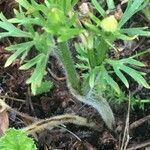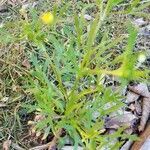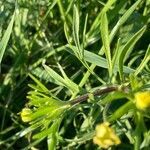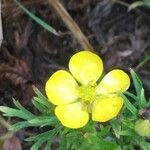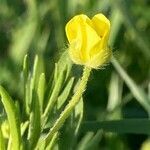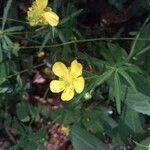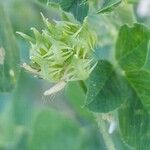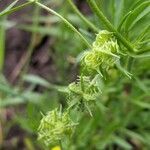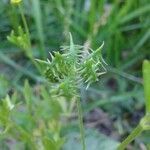Erect, sparsely pilose annual; roots fibrous. Lower leaves with petioles 1.5–7 cm long; lamina obovate or broadly spathulate, 2–4 cm long; stem-leaves trifoliolate or biternate, with obovate or linear-elliptical segments. Flowering stems 3–7 (–15)-flowered, 15–60 cm high, pedicels with sparse, recurved hairs. Sepals 5, spreading, ovate, 5–7 mm long, pale yellowish green, pilose beneath. Petals 5, obovate, 7–10 mm long, bright lemon-yellow; margins minutely ciliate; nectary near petal-base, with lobe cuneate or obovate, wider than petal just above its attachment, 1–2 mm long, free for up to half this length. Stamens 10–12. Pistils 6–12. Receptacle hirsute. Achenes broadly obovate, 6–8 mm long, strongly flattened; lateral faces with prominent spine-like tubercles to 3 mm long, longer near margins; beak 2–3 mm long, erect, straight to falcate.
Annual; roots all fibrous. Stems moderately stout, erect, pubescent above, 10-30-(50) cm tall. Basal lvs subcircular, shallowly 3-5-lobed, 2-4 × 2-4 cm, glabrous; petioles glabrous, 1.5-3 cm long. Cauline lvs 2-ternate; leaflets linear, 2-3-fid, pubescent; uppermost lvs becoming subsessile. Fls 3-7-(15) per stem, 15-20 mm diam. Pedicels erect, pubescent, terete, c. 50 mm long at fruiting. Sepals 5, with sparse long hairs, subacute, 6-7 mm long, spreading, pale yellow. Petals 5, pale yellow, obovate, c. 10 × 6 mm; nectary single, c. 0.5 mm from petal base, covered by a short broad truncate scale. Receptacle hairy. Achenes 5-8, strongly flattened, distinctly bordered, broadly obovate; body 5-7 × 4-5 mm; face with strong long curved spines especially near the margin; beak straight, 2-3 mm long.
Stems erect or ascending, sparsely pilose. Basal and lower cauline leaf blades obovate to rhombic in outline, 3-parted or 3(-5)-foliolate, 1.8-5.2 × 1.6-4.2 cm, leaflets oblanceolate or divided into oblanceolate or linear segments, leaflet base narrowly acuminate, margins entire or distally dentate, apex rounded or acuminate. Flowers pedicellate; receptacle sparsely hispid; sepals 5, spreading, 4-7 × 1-2 mm, strigose; petals 5, 5-8 × 2-4 mm. Heads of achenes discoid, 8-9 mm across; achenes 5-8 per head, 4-6.4 × 2.8-4.4 mm, faces and margin covered with long spines, glabrous; beak lance-subulate, straight, 1.6-3.8 mm.
Annual, 2–4 dm; lvs deeply divided into many linear and entire or narrowly cuneate-oblong and incised segments; fls long-pedicellate; pet obovate, 5–8 mm; receptacle hairy in fr; achenes 4–9, broadly and obliquely obovate, 4.5–7 mm, the sides and margins with numerous slender spines to 2.5 mm; beak subulate, 2–3 mm; 2n=32. Native of Europe, occasionally found as a weed in our range, esp. along the Atlantic coast. Apr.–Aug.
A herb.
